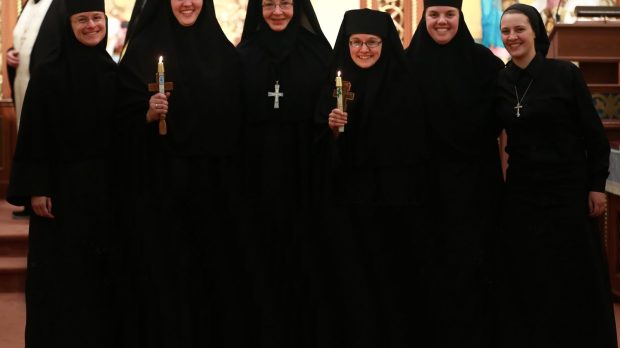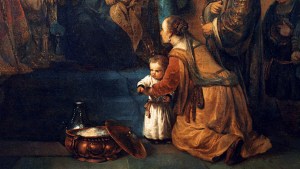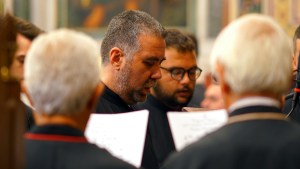It wasn’t unusual for young Celeste Strohmeyer to want to get married and have a dozen kids. After all, she was one of 11, which, she said, “provided a lot of hands-on experience with children.”
But there was a competing tug in her heart, beginning in early childhood — a call to religious life. It kept calling to her: when she was 12, when she was 16, when she was 22 and later, after establishing a promising career.
She had a good job, independence, a home of her own, the freedom to travel. She still could have married. But the thought of being a nun kept presenting itself, and, as she describes it in her written “vocation story,” she found herself anxious and constantly praying, “Jesus, help me.”
“I just wasn’t at peace. No matter what I did, what I had, what I thought, it just wasn’t enough; there was something ‘more,’” she wrote.
The inner struggle came to a crisis point, and she says she actually heard Jesus answer her cry for help with the words, “Let me.”
She spoke with a priest and took time off from work. “I disconnected the phone and kept silent and prayed throughout the day,” she wrote. “Somewhere within the silence of that day, I realized that I surrendered my resistance and said yes to God’s invitation. I found myself smiling uncontrollably. The relentless, deep, aching vacuum that nothing seemed to satisfy was now filled with an exciting peace and joy that I had never experienced before.”
As a Byzantine Catholic, Celeste entered an Eastern Catholic religious order that she had kept in touch with, the Sisters of St. Basil the Great in Pennsylvania. She who had once dreamed of being a mother was now a sister, and with her work in youth ministry, experienced a kind of spiritual motherhood.
Nagging voice
And yet, “that familiar nagging” came to her again after 13 years in religious life. Again, it’s not an unusual thing. There are examples of people in religious life who discover a new path after some years in the community to which they had been called: Mother Teresa’s “call within a call” as a Loreto Sister, for example, to leave that community to serve the “poorest of the poor” in India.
Around the same time Sister Celeste entered religious life, Pope John Paul II wrote an apostolic letter, Orientale Lumen (“Light of the East”), which emphasized the Eastern Catholic churches’ need to revive their ancient identity. Part of the letter contained a call for the Eastern churches to revive the monastic tradition.
“In the East, monasticism has retained great unity,” wrote Pope John Paul, whose mother was likely a Byzantine Catholic. “It did not experience the development of different kinds of apostolic life as in the West. The various expressions of monastic life … correspond more to different stages of the spiritual journey than to the choice between different states of life.”
Sister Celeste said she was attracted to and edified by the pope’s call and wondered if it was the “something more” to which God seemed to be calling her.
Providentially, in 2008, Bishop John Kudrick of the Ruthenian Eparchy (Diocese) of Parma, Ohio, published a letter based on Orientale Lumen, which expressed his vision for monasticism in his Eastern Catholic eparchy, which covers 12 Midwestern states.
“It is clear to me that the Eparchy of Parma needs the witness, example and service that only well-established and vibrant monasticism can give,” the bishop wrote. “The monastics will not be substitutes for the holiness of the rest of us but will ‘witness to the fact that we Christians are at different stages of the spiritual journey,’ inviting all to a deeper spirituality,” he wrote, quoting from John Paul’s letter. “They shall engage in study to ‘contemplate Christ in the hidden recesses of creation and in the history of humankind … seeking the meaning of life’ and to provide the Church at large with inspiration to respond to the needs of the moment.”
Sister Celeste faced a “gut-wrenching decision,” but the call was strong enough for her to seek a leave of absence from the Basilian Sisters. Along with another young aspirant who had read Bishop John’s letter, she began to live a monastic life in Parma.
Restoring traditions
After a year, she decided not to return to the Sisters of St. Basil. In 2010 Bishop John gave the fledgling community official status, and the following year Sister Celeste made her life profession. She was given the name Mother Theodora, after a martyred Ukrainian bishop who was beatified by Pope John Paul, Theodore Romzha. Christ the Bridegroom Monastery now consists of six nuns, including two who made their life profession in November.
Christ the Bridegroom, in the town of Burton, Ohio, is only the second traditional Byzantine Catholic monastery for women in the U.S., the other being Holy Theophany in Olympia, Washington.
“There were attempts, beginning before Vatican II or straight after Vatican II,” said Abbot Nicholas Zachariadis of Holy Resurrection, a Byzantine Catholic men’s monastery in St. Nazianz, Wisconsin, in an interview. “They couldn’t be fully Eastern. They had to be like Byzantine Franciscans or Byzantine Carmelites, which is kind of a hybrid.”
Abbot Nicholas said that Christ the Bridegroom is part of a trend in Eastern Catholicism to return monastic life to a time before it suffered a dichotomy between contemplative and active religious life, or when religious orders became known for various charisms: teachers, preachers, nurses, social workers, missionaries and the like. “That was good for the time, but as we’re in a post-Christian era, culturally, I think the greater flexibility the better,” he said.
In addition, in June 2014, Pope Francis restored the faculty of Eastern Catholic bishops “outside of the traditional Eastern territories” (Eastern Europe and the Middle East, for example) to admit married men to the priesthood “according to the traditions of their respective churches.” As in the Orthodox churches, many Eastern Catholic churches allow married men to become priests and deacons, although bishops are chosen from among celibate clergy, primarily monks.
“As married priesthood becomes more common, Byzantine monastics will continue to witness to Apostolic celibh vnacy and provide a pool of worthy candidates for the episcopacy,” Abbot Nicholas said.
In addition, spiritual motherhood as well as a spousal relationship with Christ play important roles in the spirituality at Christ the Bridegroom. As the community describes itself on its website, “We are … dedicated to a vigilant life of prayer and hospitality according to the traditions of the Christian East. Laying down our lives in imitation of the Bridegroom, we … participate in the dynamic love of the Trinity by sharing a life of prayer, work and recreation. … Meditating on Scripture, especially the Song of Songs, and immersing ourselves in a life of personal and liturgical prayer, we enter into a spousal relationship with Christ the Bridegroom. Looking to the Theotokos as our model, we open ourselves to the Divine life of the Holy Spirit, bearing forth fruit for the Church and the world. Our monastery provides a spiritual garden and a bridal chamber in which we draw others into this same life-giving relationship with Christ the Bridegroom.”
Spiritual motherhood
One of those who made her life profession last November, Mother Gabriella, wrote in an online reflection that a priest-friend of hers had quipped, “Your name is going to be Mother soon! I am going to call you ‘Mom’ — and I’m coming to you for spiritual direction.”
“It was true!” Mother Gabriella wrote. “Soon I would be making my life profession and setting aside biological motherhood to fully embrace my vocation as a nun and spiritual mother of priests and of souls …”
Eastern monastics follow a way of life that is more reminiscent of, say, Trappist monks, with set times for community prayer, which is chanted, and work and study. The liturgy and the Divine Office follow the Eastern Orthodox style, characterized by much repetition of prayers, especially the constant refrain in litanies of “Lord Have Mercy,” prostrations before icons and multitudinous blessing of self with the sign of the cross.
“We have a more contemplative vocation, but we’re not cloistered,” Mother Gabriella said in an interview. “One of our main focuses is prayer. We’re on a monastic schedule. We’re in chapel four to five hours a day praying the Byzantine Office, as well as having personal prayer time.”
On their own, nuns might spend time meditating on the mercy of God, fingering their chotkis as they repeat the Jesus Prayer over and over: “Christ Jesus, son of the living God, have mercy on me, a sinner.”
Yet they definitely remain open to the world. “Our other focus is hospitality, drawing people to the monastery to minister to them, whether that’s on retreats or to share a meal or prayer with us or to come and spend time at the monastery,” Mother Gabriella explained.
Unlike convents in the Latin tradition, there could be several “mothers” as well as “sisters.” Sisters are those in formation, while mothers are those who have made their life profession. A nun is given the title of “Mother” to express the fruitfulness of her union with Christ. Among the mothers, one is chosen to be abbess, known in Greek as “hegumena.”
Bishop John designated Mother Theodora hegumena, giving her a pectoral cross that he had received from Pope John Paul II.
Also distinguishing the nuns is the traditional Eastern monastic habit.
“Typically, the color is black, which represents death to self. We always think of it as the soil,” said another monastic, Mother Cecilia. “Jesus says that if a grain of wheat dies and falls to the ground it gives life. We think of the life that comes out of that when we die to ourselves.”
“The question we get from a lot of people is, ‘Are you Muslim?’” Mother Gabriella quips. But on a more serious note, she explains that the fact that nuns’ hands, faces and feet are the only things exposed symbolizes the way in which the monastics serve God and others. “Those are the ways we express God’s love, through a hug or a smile,” she said. “Our habit is not only the clothes we wear but the demeanor in the way in which we love.”
Several women are in conversation with Mother Theodora about the possibility of entering the monastery, and recent renovations have been made with the view of possible growth. In the meantime, those spaces are being used by visitors who seek a place of prayer and quiet retreat.
“We hope also to build more hermitage cabins. That seems to be the greatest need right now,” Mother Cecilia said.
Bishop John had written in his letter that the monastics should have adequate time for silence, “to courageously meet one’s self, without the deafening of noise.”
Silence, it seems, is the precious commodity lacking in so many people’s lives today. But it was in the silence that Celeste Strohmeyer originally heard God’s call clearly, setting her off on a life pilgrimage.
“This journey of mystery continues and draws me ever deeper into that ‘something more,’” said Mother Theodora. “My deep desire for motherhood, which has always been so intricately woven in the very fabric of my being, has conceived spiritual fruitfulness that I didn’t believe was possible. God has blessed me with many beautiful, spiritual children which in an unexplainable way, I truly feel I bore in my womb.”
The universal Church, East and West, has just concluded a Year for Consecrated Life, and Pope Francis said at the Vatican on Monday that it’s sometimes difficult for him to have hope, especially when it comes to vocations. He described his sadness hearing about religious orders and monasteries with few members, or communities where priests and nuns were getting older without people to carry on their work.
Time will tell, but if the prayers and dedication of the nuns of Christ the Bridegroom Monastery bear fruit, Pope Francis will have reason for greater hope.
This article was originally published on February 1, 2016.



